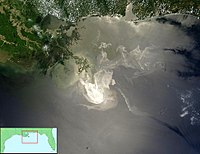
Photo from wikipedia
Due to the high difficulties, high investment, and high risks in deepwater oil and gas well testing, major safety problems can occur easily. A key to prevent accidents is to… Click to show full abstract
Due to the high difficulties, high investment, and high risks in deepwater oil and gas well testing, major safety problems can occur easily. A key to prevent accidents is to conduct safety assessment and control on deepwater testing and to improve the testing technology. The deepwater of the South China Sea has some special environmental features: long distance from offshore, frequent typhoons in summer and constant monsoons in winter, and the presence of sandy slopes, sandy ridges and internal waves, coupled with the complex properties of oil and gas reserves which bring more challenges to deepwater well testing. In combination with deepwater well testing practice in the South China Sea, this paper analyzes the main potential risks in deepwater well testing and concludes that there are risks of failures of testing string, tools, and ground processes. Other risks are gas hydrate blockage, reservoir stratum sanding, and typhoon impacts. Specific precautions are also proposed in response to these risks in the paper.
Journal Title: Engineering
Year Published: 2019
Link to full text (if available)
Share on Social Media: Sign Up to like & get
recommendations!